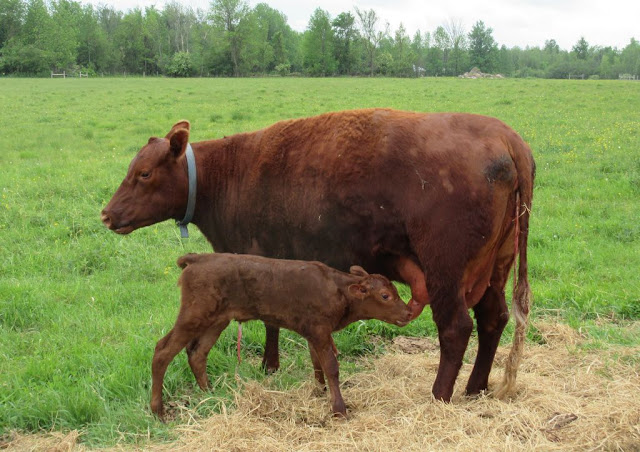The chart I was given by the Artificial Insemination man used 280 days as the gestation period for cattle, and by that reckoning, Amy was a week late. Her udder was swollen and sore looking, and she seemed uncomfortable. A Google search informed me that up to 291 days is "normal" and for Red Polls, the average is 285 days. So I just waited and watched her as she looked miserable:
But nothing happened, so on day 287, I drove to Walmart to do some shopping. When I arrived home, I found Amy and her brand new heifer calf:
Amy's teats were swollen so big that I feared the baby couldn't drink from them. She was unable to do so when I took this photo. But even as I snapped the picture, I could see milky froth in the calf's mouth - so I knew she had already managed to find a way:
Amy, like Scarlett - but unlike Violet and Gracie, left her new baby hiding in the grass for most of the day in the manner of deer. That got me wondering if the calf's genetics or the mother's genetics determined which mothering style they'd use. Then it occurred to me that both Violet and Gracie calved when the grass was too short for hiding. Scarlett and Amy calved when the grass was tall enough. I still don't know the origins of mothering style:
It's very unusual to have three heifer calves in a row, and even more unusual to have four in a row (by adding Rosella into the count). That raised yet another question - Do bulls determine the gender of the offspring in the same manner as humans? I found no answer on the internet although I found other people wondering the same thing. If so, that should prove a powerful advertisement for bulls whose semen produces a preponderance of heifers:
I named the new girl Loretta but didn't see much of her for the first several days. Amy kept her hidden and, if I walked too close, they'd trot off across the field to keep away from me:
One day I walked right up to the two of them, sleeping in the grass. Neither one moved as I talked to them and brushed off the pesky flies. I think they were trying to avoid biting flies and considered me less of a threat than the insects:
Amy refused any grain for the first few days, as did Gracie and Violet before her. That got me speculating also. Was it just to avoid human contact right after calving or was it a survival behavior because their udders were painfully swollen? A retired dairyman neighbor stopped by to warm me that Amy's udder looked to be in danger of mastitis. I shared his concern but had watched the other cows swell up similarly and then gradually return to normal as their calves' appetites grew. Red Polls are beef cattle but have a great deal of dairy genetics. They produce much more milk than most beef breeds:
After a couple of days, Amy began bringing Loretta over to the barn and with her as the herd grazed:
And she began letting me get closer - but not too close:
All has gone well with Amy and Loretta, though I've been keeping a close eye on her swollen udder. I've been so very happy with the three calves produced by this bull that I plan to buy more of his semen for next year:












No comments:
Post a Comment
Note: Only a member of this blog may post a comment.